Introduction
Pig’s trotters, often underestimated as a culinary delight, hold a rich tradition and flavor profile that can captivate the taste buds of even the most discerning food enthusiasts. Stewed pig’s trotters, in particular, are a testament to the art of slow cooking, where patience and precision yield a dish that is as comforting as it is nutritious. This article aims to guide you through the intricacies of preparing stewed pig’s trotters, ensuring that every bite is a delightful explosion of flavors and textures. From selecting the perfect ingredients to mastering the cooking process, we’ll cover every step necessary to achieve a dish that is not only delicious but also a showcase of culinary prowess.
Section 1: Selecting the Right Ingredients
The foundation of any great stew lies in the quality of its ingredients. When it comes to stewed pig’s trotters, this principle is doubly important.
1 Pig’s Trotters
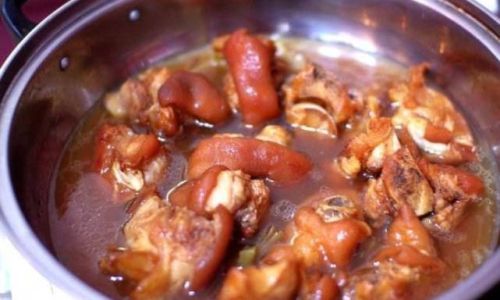
Start with fresh, high-quality pig’s trotters. Ideally, source them from a reputable butcher or farm that prioritizes animal welfare and quality. Look for trotters that are firm to the touch, with no signs of discoloration or off odors. Freshness is key, as it ensures that the final dish will be free from unwanted flavors and textures.
2 Aromatics and Seasonings
Aromatics such as garlic, ginger, and onions form the backbone of the stew’s flavor profile. Use fresh, robust ingredients that can stand up to the long cooking process. Seasonings like soy sauce, dark soy sauce for color, Shaoxing wine (or dry sherry as a substitute), and rock sugar add depth and complexity. Don’t overlook the importance of star anise, cloves, and cinnamon sticks, which provide a subtle sweetness and warmth that complements the pork perfectly.
3 Vegetables and Soy Products
Adding vegetables like carrots, daikon radish, and bamboo shoots not only enhances the nutritional value of the dish but also contributes to its visual appeal and texture. Soy products like tofu or taukwe (fermented bean curd) can absorb the rich broth, adding another layer of flavor to the stew.
Section 2: Preparation and Blanching
Before diving into the stewing process, proper preparation and blanching of the pig’s trotters are crucial.
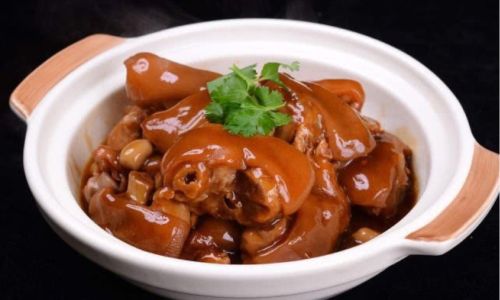
1 Cleaning and Trimming
Thoroughly clean the pig’s trotters by removing any hair, dirt, or debris. Trim off any excess fat or skin, but be mindful not to remove too much, as some fat can contribute to the stew’s richness.
2 Blanching
Blanching the trotters helps to remove impurities, tighten the meat, and create a cleaner flavor profile. Place the trotters in a pot of boiling water, add a few slices of ginger and a splash of rice vinegar to help neutralize any unwanted smells. Blanch for about 5-7 minutes, then remove and rinse under cold water to stop the cooking process. This step also makes it easier to remove any remaining hair or tough skin.
Section 3: The Stewing Process
Now, we delve into the heart of the matter – the stewing process. This is where patience and attention to detail truly shine.
1 Building the Base
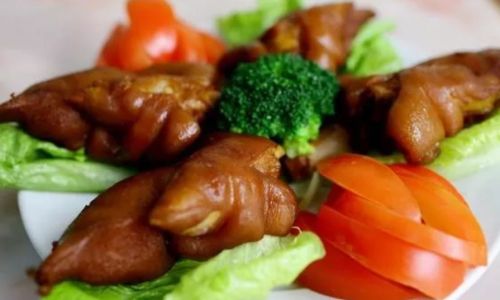
In a heavy-bottomed pot or wok, heat a small amount of oil over medium heat. Add chopped garlic, ginger, and onions, and sauté until fragrant. This creates the foundation of the stew’s aroma.
2 Adding the Trotters
Place the blanched trotters into the pot, skin side down. Sear them until they develop a golden-brown crust, which will add flavor and help the trotters retain their shape during the stewing process.
3 Seasoning and Aromatics
Pour in enough water or broth to fully submerge the trotters. Add the soy sauce, dark soy sauce, Shaoxing wine, and rock sugar. Tie the star anise, cloves, and cinnamon sticks in a cheesecloth or spice bag and add it to the pot. This ensures that the spices flavor the broth without becoming overpowering.
4 Simmering
Bring the mixture to a boil, then reduce the heat to a gentle simmer. Cover the pot and let the trotters cook slowly, allowing all the flavors to meld together. The cooking time can vary depending on the size and age of the trotters, but generally, expect a minimum of 2-3 hours. For maximum flavor extraction and tender meat, cooking overnight on the lowest setting of a slow cooker is ideal.

5 Adding Vegetables and Soy Products
About 30-45 minutes before the trotters are done, add the prepared vegetables and soy products. This allows them to cook through without becoming mushy. Adjust the seasoning with additional soy sauce or salt if necessary, and taste the broth regularly to ensure it’s balanced and to your liking.
Section 4: Finishing Touches
The final steps are crucial for elevating the stew from good to great.
1 Thickening the Broth
If the broth is too thin, you can thicken it by removing the trotters and vegetables, then simmering the broth uncovered until it reaches your desired consistency. Alternatively, you can mix a slurry of cornstarch and water and add it to the broth, stirring constantly until it thickens.
2 Garnishing
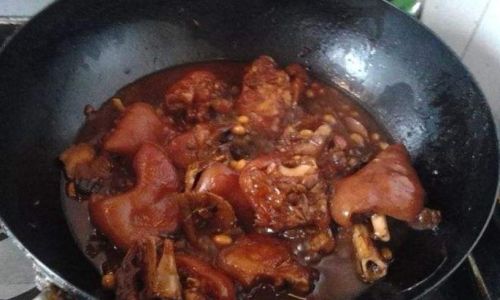
Before serving, garnish the stewed pig’s trotters with chopped scallions, cilantro, or a sprinkle of sesame seeds for added freshness and color. A drizzle of chili oil or a sprinkle of Sichuan peppercorns can add a spicy, aromatic kick.
3 Serving
Serve the stewed pig’s trotters hot, with a side of steamed rice or noodles to soak up the delicious broth. Each bite should be a harmonious blend of tender meat, flavorful vegetables, and rich, aromatic broth.
Conclusion
Stewed pig’s trotters are a culinary journey that rewards patience and attention to detail. By following the steps outlined in this article, you can create a dish that is not only a feast for the senses but also a testament to your culinary skills. Remember, the key to success lies in selecting high-quality ingredients, meticulous preparation, and a gentle, slow cooking process that allows all the flavors to develop fully. With practice, you’ll soon master the art of stewing pig’s trotters, delighting friends and family with each succulent, flavorful bite. Happy cooking!
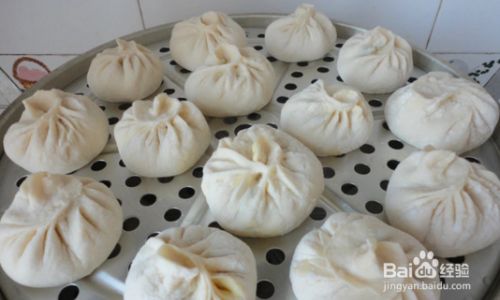
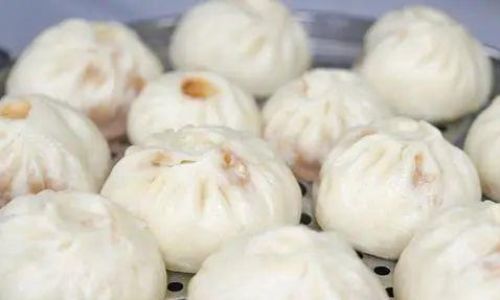
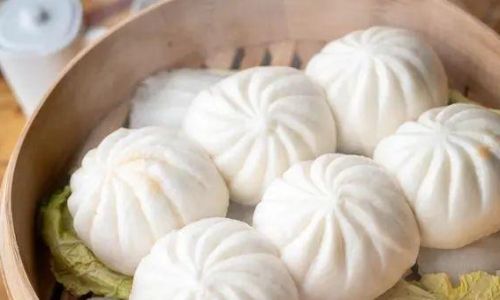
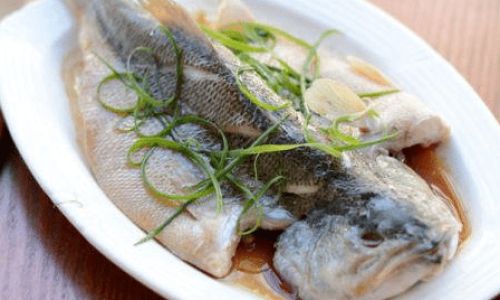
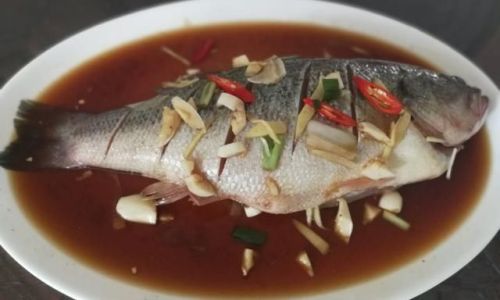
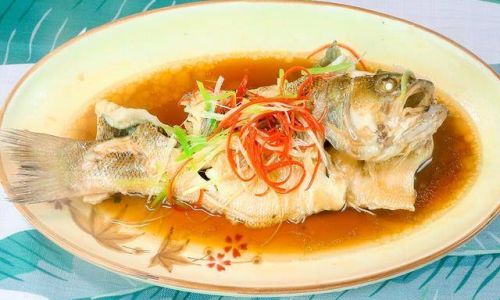
0 comments